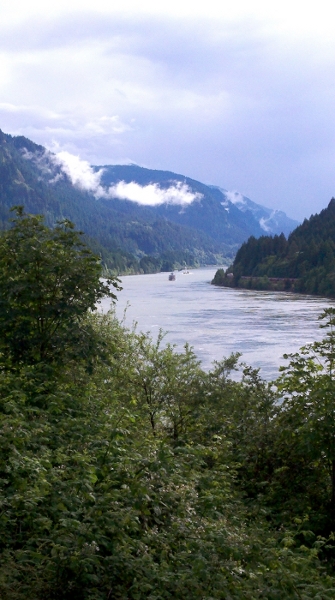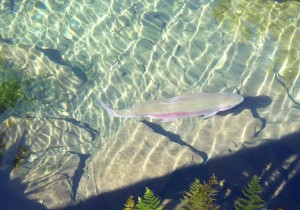It’s no surprise that the watersheds of streams and rivers often mark the boundaries and definitions of bioregions. While ponds and lakes are lovely in their own right, moving water moves us in a way no still, quiet pool does. In a way, rivers, streams, creeks and their ilk are the bloodstream of the land, carrying necessary nutrients and other resources to ecosystems all along their lengths. We humans have made great use of their capacity for locomotion; every day we move everything from timber to wheat, vehicles to people, up and down their liquid tracks.

Human dependence abounds as well. Industries use the waterway to carry goods up and down its length. Many communities rely on the series of hydroelectric dams placed across it over the years. Recreation is on the rise; residents and visitors alike fish, boat, windsurf, and otherwise enjoy the broad expanse of water. Tourist locations along the river, such as Multnomah Falls, increase local revenue.
For all the value we place on the Columbia, some have been taking it for granted. Foreign coal interests plan to move thousands of tons of coal per year via barges and uncovered train cars. This not only raises the amount of barge traffic on the river, which can be dangerous to people using the river recreationally, but also puts more of an environmental strain through barge pollution and loose coal dust in the air and water. The exporters aren’t allowed in just yet; the potential environmental impact has yet to be assessed, and the issue is up for public comment.
Attacking the river from another angle, the Nestle Corporation wants to set up a bottling plant taking water directly from a spring that feeds into the river. This would necessitate building the bottling plant, with all the pollution that entails, plus providing yet another potential source of pollutants going into the Columbia itself. There’s a public comment event on Dec. 7 here in Portland; I’ll see about posting follow-up as I plan to go. As of 29 November, the public meeting has been canceled–more information here.

For all these assaults, the Columbia isn’t without its defenders. Friends of the Columbia Gorge engage in activism, as well as organized educational hikes along the many trails in the Gorge. Nestle’s attempts in particular are countered by the Keep Nestle Out of the Gorge Coalition; among others, this coalition includes Bark, an organization dedicated to protecting the wilderness around Mt. Hood. For those who prefer to protect the river, its tributaries and watersheds through hands-on volunteering, there are organizations like the Lower Columbia River Estuary Partnership, SOLV, Columbia Riverkeper, and Willamette Riverkeeper, among others.
I could say that the Columbia River is fortunate to run through an area that is so full of people conscious about sustainability and environmental issues. To an extent this is true, but there are too many reasons the river needs protection in the first place. Our industries, while beneficial in many ways, were not originally created with the environment in mind. Instead a linear ideal of progress, ever higher and more complex, took the center stage. And while the stretch of the Columbia between Portland and the Cascades has a lot of advocates, this is just a small portion of the river itself, much of which has been affected by dams, industries, and more.
Perhaps Woody Guthrie’s words in “Talking Columbia” were taken a bit too optimistically when he sang how the dams on the river:
“Run a thousand factories for Uncle Sam.
…
Makin’ ever’thing from sewing machines to fertilizer
Atomic bedrooms!… Plastic!
Everything’s gonna be made out of plastic!

It will take all of us–volunteers, nonprofit organizations, and other advocates–to keep the Columbia from being degraded beyond repair. We’re not defeated yet, though. A recent study by the Oregon Department of Environmental Quality shows that while there is plenty of work to do, some factors such as water quality could be much worse (our river hasn’t caught on fire yet, for example). There is hope, and we can hang onto that as we continue our efforts to save the Columbia River.












